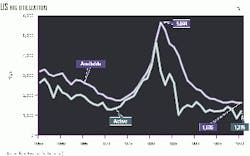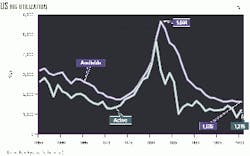Drilling activity and dayrates continue to rise
The good news is that US drilling activity is up a record 41% from year-ago levels, but the best news is that day rates are up, too, and likely to continue rising with the available rig fleet at an all time low, reported officials of Reed-Hycalog, a unit of Schlumberger Ltd., in its annual rig census.
"The only bad portion of this story would be if you're looking for a rig," said John Deane, Reed-Hycalog's president, as he revealed results of that latest survey at the annual meeting of the International Association of Drilling Contractors in Houston.
Reed officials counted a total of 1,215 rigs working in the US and its waters during the survey period of May 6-June 19, up from 860 a year ago (Fig. 1).
There was a net loss of 8 rigs from the US fleet during the 12 months since the 1999 census, leaving a total 1,636 rigs available for work-the lowest level in the 48 years that the company has made its annual tally (Table 1).
That means 74% of all available rigs were working at some point during the 45-day census period, up from just over 52% a year ago and slightly above the historic average of 73%, said Deane.
But that count came before a big surge in drilling activity this summer. "If the census were taken today, I believe that number (of working rigs) would be more like 1,350," Deane said. Current rig utilization is probably around 80%, considered a healthy level by most industry experts, he said.
Virtually everyone expects the ramp-up in drilling to continue. At the time of the survey, drilling contractors estimated that the number of working rigs would increase on average another 27% in the coming year.
Based on the rig count at the time of the survey, Deane said, "that would indicate a weekly rig count of roughly 1,100"-a number that has already been surpassed.
Reed officials are predicting US drilling activity will increase another 20%, with some 1,450 rigs working at this time next year. "We believe that rig availability will remain relatively unchanged at around 1,600 rigs, which will bring our utilization rates dangerously close to 90%, the healthiest rate we have seen in many years," said Deane.
The pressure of a pending 30 tcf US gas market by 2010 is expected to continue pumping up demand for drilling. "Even if (US President Bill) Clinton and (Vice-President Al) Gore do dip into the (emergency oil) stockpile to lower prices for Nov. 7, there is no strategic natural gas reserve. With more than 80% of the rigs looking for gas, the market will get tighter," said Deane.
An acute labor shortage is the main constraint on drilling activity today, he said. Crew availability has replaced rig rates as the primary concern among drilling contractors, up from No. 2 position a year ago.
Safety issues
"Loss of a generation of experienced help is difficult to rebuild, especially in our roller coaster market, and at a time when the US unemployment rate remains at historic lows," said Deane. "The tremendous strides we have made in drilling efficiency, accuracy, and work safety will be in jeopardy without qualified people."
Safety is the primary concern among producers who employ drilling contractors, said Randall Kubota, general manager of international drilling for Texaco Inc., at that same session. Industry statistics showing fewer lost-time accidents among international drilling crews than among US crews "tell me there's an opportunity for improvement," he said.
Lack of experienced drilling crews is the second top concern among producers, with the too-high percentage of rig downtimes during drilling operations in third place, ahead of rising rig rates, Kubota said.
Availability of rig parts is the third major concern among drilling contractors this year, after rig rates, Deane reported.
Of the 74 total rigs added to the rig fleet this year, the largest portion-34-were assembled from component parts. That's up from 9 in 1999, but down from 62 in 1998. "We're just running out of old rigs and parts for this to be a sustainable method of building rigs," said Deane.
Only 24 rigs were scrapped this year, down from 41 in 1999. "Fewer rigs being scrapped certainly indicates that this low-cost source of replacement parts is close to being depleted," Deane added.
There were 82 rigs dropped from this year's census, compared to 100 last year. The biggest portion, 40, were taken out because of the large investments required to put them to work-more than $100,000 for land rigs and $1 million for offshore rigs.
Another 12 were deleted from the fleet list after remaining idle for the past 3 years. Four left the US for other markets and two were destroyed by fire.
Among rig additions, 22 were reactivated after sitting idle for a number of years, 12 moved to the US from other markets, and 6 were newly constructed-5 mobile offshore units in the Gulf of Mexico and a land rig in Louisiana.
The last of the new mobile offshore rigs ordered during the 1997 drilling boomlet are almost ready for delivery. But most of the drilling contractors surveyed by Reed said they plan to expand their current rig fleets.
Although 80% of the contractors reported higher rig rates, finances generally are still below the levels necessary for speculative construction of new rigs.
M&A activity
An alternative means of increasing fleet size is through mergers and acquisitions, which are expected to accelerate in the current environment.
More of the small-to-midsize contractors are attempting to position themselves in specific markets and are seeking the advantages of size and scale. "This will hopefully lead to increases in market efficiency and profitability," Deane said.
There are now 208 US drilling contractors, 11 fewer than in 1999. Among those survivors are 16 large companies with 20 or more rigs.
"Those 16 own 58% of all US-based rigs, the highest percentage ever reported. By comparison, in 1993 only nine of 388 contractors were in the large group, and they owned just 20% of the fleet," said Deane.
In the annual Reed survey, contractors are asked what level of oil and gas prices would have a positive effect on their business. This year's responses averaged $27.63/bbl for oil, up from $19.30/bbl in 1999; and $3.65/Mcf for gas, up from $2.58/Mcf. Those averages are well below current levels.
In the current bullish market, Deane said, "Contractors seem relatively confident that commodity prices won't take another scary dive. And that worries me."


